Business Communication Report: Analysis of Mr. Fishy's Practices
VerifiedAdded on 2021/02/19
|10
|2205
|14
Report
AI Summary
This report examines the business communication practices within Mr. Fishy, a small organization in London, focusing on its internal communication challenges. The report explores the importance of communication, differentiating between formal and informal channels, and analyzing their purposes and principles. It identifies issues such as weak formal communication, cultural tensions among staff, and the impact of these factors on employee relations. The analysis includes an evaluation of the application of effective communication principles like clarity, appropriate language, attention, consistency, and feedback. The report provides suggestions to improve communication, including the need for a stronger formal communication system, addressing conflicts, and fostering better human relations through open dialogue and feedback mechanisms. The conclusion emphasizes the importance of communication as the backbone of the organization and suggests implementing effective communication strategies to resolve conflicts and enhance overall organizational performance.
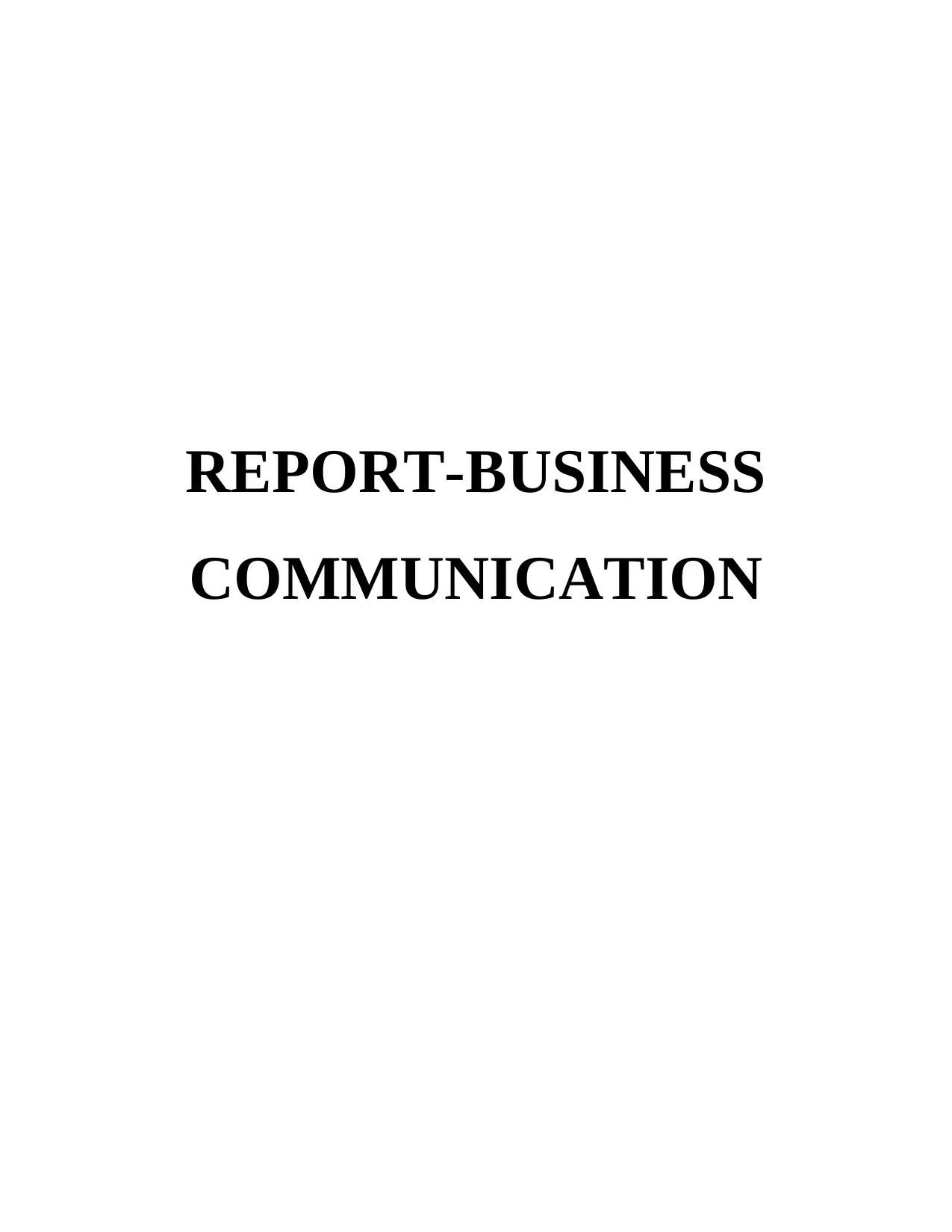
REPORT-BUSINESS
COMMUNICATION
COMMUNICATION
Paraphrase This Document
Need a fresh take? Get an instant paraphrase of this document with our AI Paraphraser
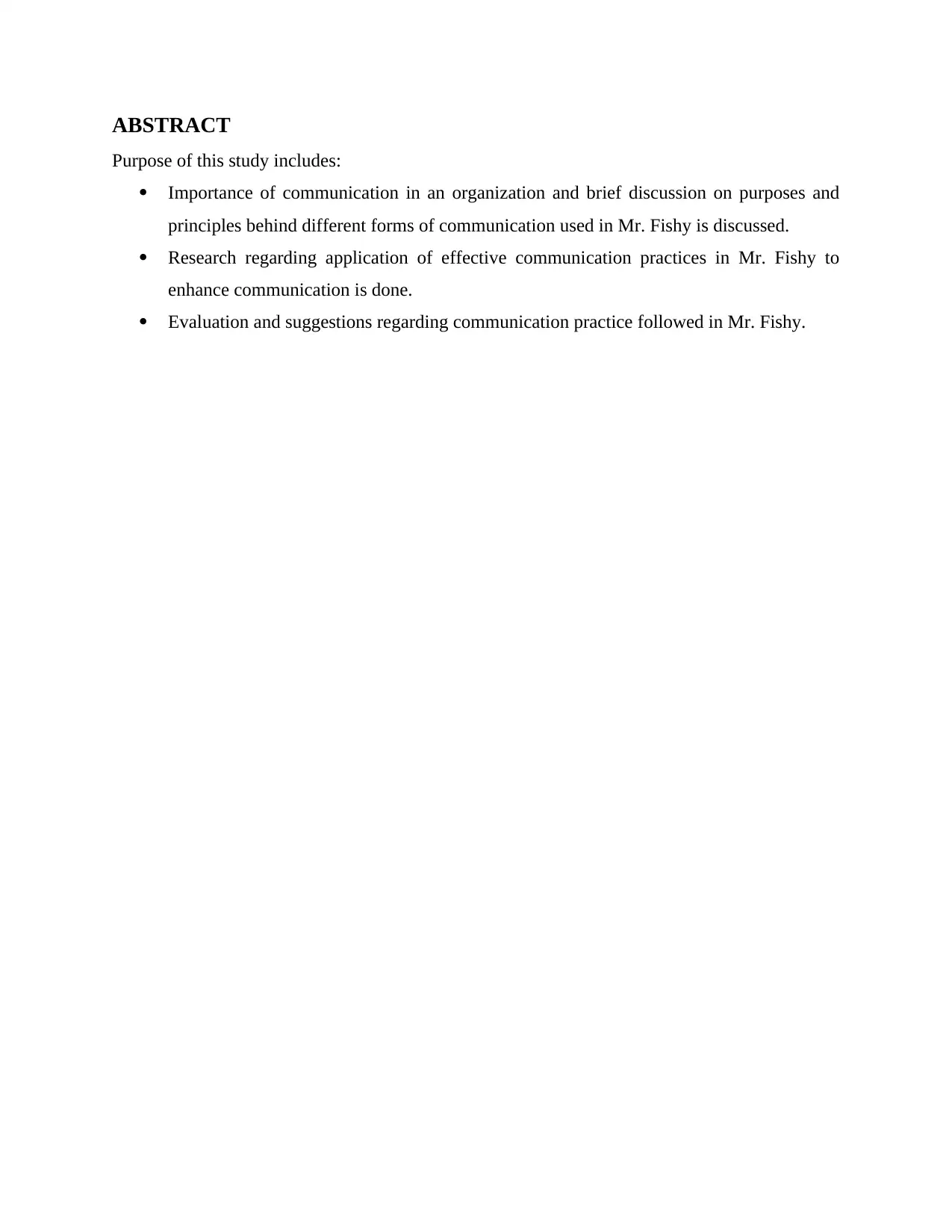
ABSTRACT
Purpose of this study includes:
Importance of communication in an organization and brief discussion on purposes and
principles behind different forms of communication used in Mr. Fishy is discussed.
Research regarding application of effective communication practices in Mr. Fishy to
enhance communication is done.
Evaluation and suggestions regarding communication practice followed in Mr. Fishy.
Purpose of this study includes:
Importance of communication in an organization and brief discussion on purposes and
principles behind different forms of communication used in Mr. Fishy is discussed.
Research regarding application of effective communication practices in Mr. Fishy to
enhance communication is done.
Evaluation and suggestions regarding communication practice followed in Mr. Fishy.
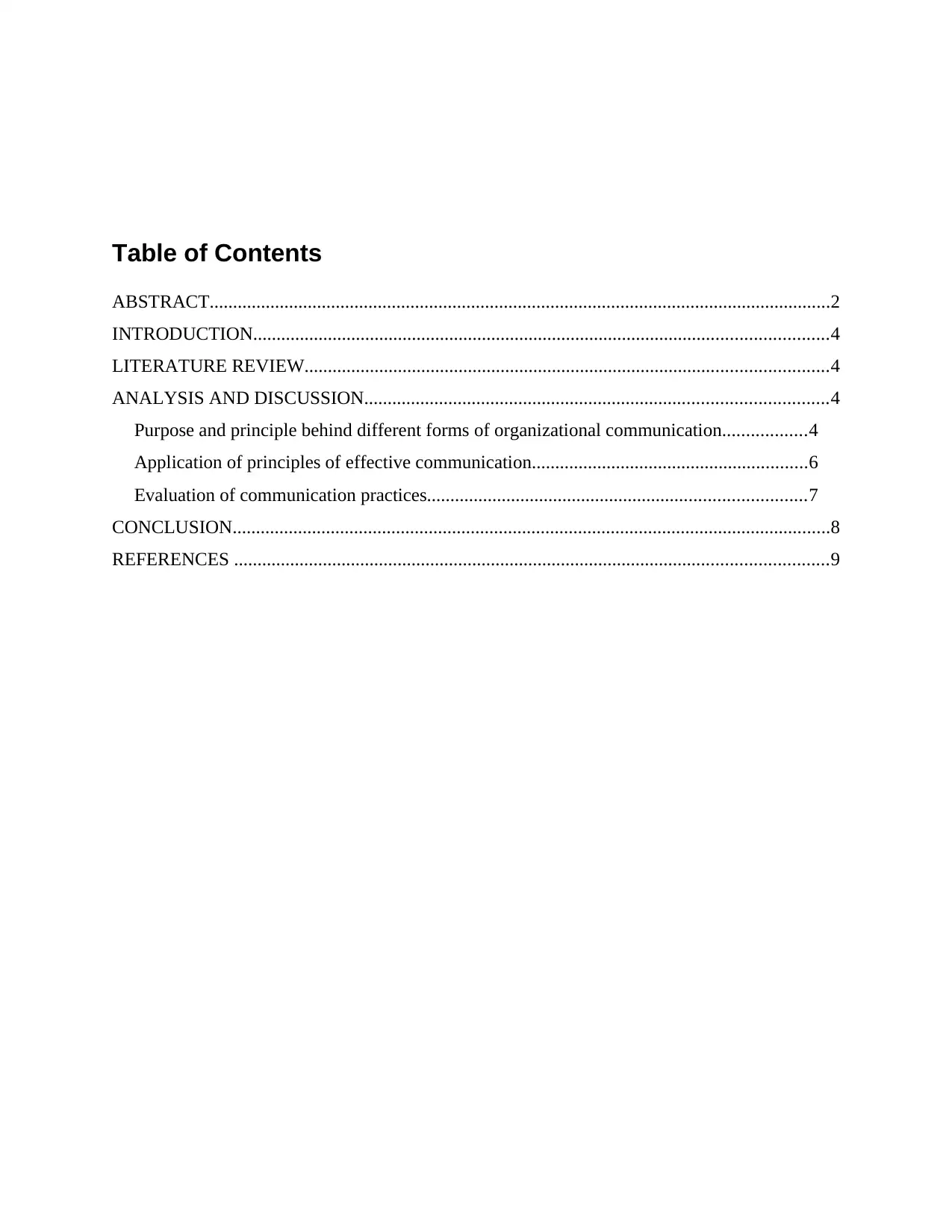
Table of Contents
ABSTRACT.....................................................................................................................................2
INTRODUCTION...........................................................................................................................4
LITERATURE REVIEW................................................................................................................4
ANALYSIS AND DISCUSSION...................................................................................................4
Purpose and principle behind different forms of organizational communication..................4
Application of principles of effective communication...........................................................6
Evaluation of communication practices.................................................................................7
CONCLUSION................................................................................................................................8
REFERENCES ...............................................................................................................................9
ABSTRACT.....................................................................................................................................2
INTRODUCTION...........................................................................................................................4
LITERATURE REVIEW................................................................................................................4
ANALYSIS AND DISCUSSION...................................................................................................4
Purpose and principle behind different forms of organizational communication..................4
Application of principles of effective communication...........................................................6
Evaluation of communication practices.................................................................................7
CONCLUSION................................................................................................................................8
REFERENCES ...............................................................................................................................9
⊘ This is a preview!⊘
Do you want full access?
Subscribe today to unlock all pages.

Trusted by 1+ million students worldwide
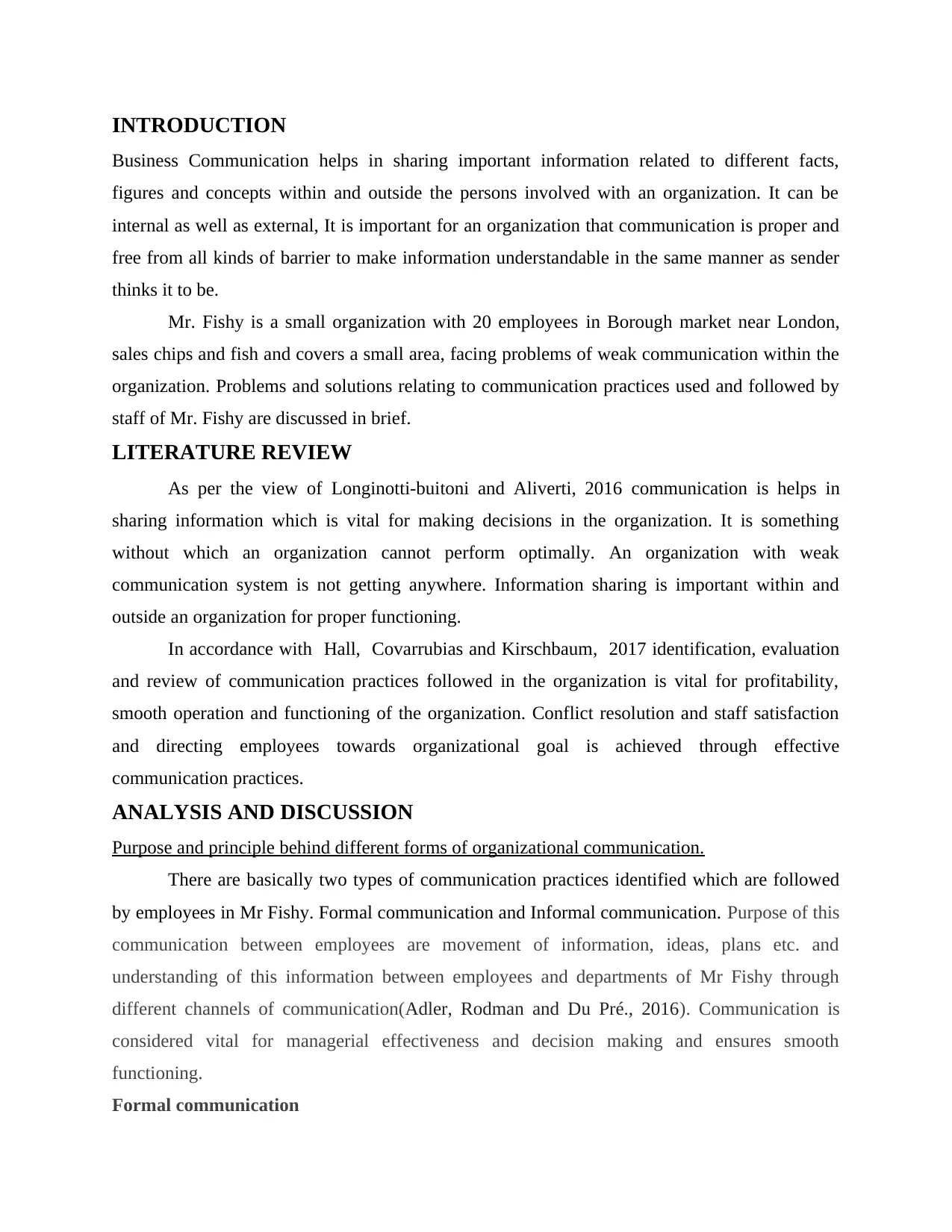
INTRODUCTION
Business Communication helps in sharing important information related to different facts,
figures and concepts within and outside the persons involved with an organization. It can be
internal as well as external, It is important for an organization that communication is proper and
free from all kinds of barrier to make information understandable in the same manner as sender
thinks it to be.
Mr. Fishy is a small organization with 20 employees in Borough market near London,
sales chips and fish and covers a small area, facing problems of weak communication within the
organization. Problems and solutions relating to communication practices used and followed by
staff of Mr. Fishy are discussed in brief.
LITERATURE REVIEW
As per the view of Longinotti-buitoni and Aliverti, 2016 communication is helps in
sharing information which is vital for making decisions in the organization. It is something
without which an organization cannot perform optimally. An organization with weak
communication system is not getting anywhere. Information sharing is important within and
outside an organization for proper functioning.
In accordance with Hall, Covarrubias and Kirschbaum, 2017 identification, evaluation
and review of communication practices followed in the organization is vital for profitability,
smooth operation and functioning of the organization. Conflict resolution and staff satisfaction
and directing employees towards organizational goal is achieved through effective
communication practices.
ANALYSIS AND DISCUSSION
Purpose and principle behind different forms of organizational communication.
There are basically two types of communication practices identified which are followed
by employees in Mr Fishy. Formal communication and Informal communication. Purpose of this
communication between employees are movement of information, ideas, plans etc. and
understanding of this information between employees and departments of Mr Fishy through
different channels of communication(Adler, Rodman and Du Pré., 2016). Communication is
considered vital for managerial effectiveness and decision making and ensures smooth
functioning.
Formal communication
Business Communication helps in sharing important information related to different facts,
figures and concepts within and outside the persons involved with an organization. It can be
internal as well as external, It is important for an organization that communication is proper and
free from all kinds of barrier to make information understandable in the same manner as sender
thinks it to be.
Mr. Fishy is a small organization with 20 employees in Borough market near London,
sales chips and fish and covers a small area, facing problems of weak communication within the
organization. Problems and solutions relating to communication practices used and followed by
staff of Mr. Fishy are discussed in brief.
LITERATURE REVIEW
As per the view of Longinotti-buitoni and Aliverti, 2016 communication is helps in
sharing information which is vital for making decisions in the organization. It is something
without which an organization cannot perform optimally. An organization with weak
communication system is not getting anywhere. Information sharing is important within and
outside an organization for proper functioning.
In accordance with Hall, Covarrubias and Kirschbaum, 2017 identification, evaluation
and review of communication practices followed in the organization is vital for profitability,
smooth operation and functioning of the organization. Conflict resolution and staff satisfaction
and directing employees towards organizational goal is achieved through effective
communication practices.
ANALYSIS AND DISCUSSION
Purpose and principle behind different forms of organizational communication.
There are basically two types of communication practices identified which are followed
by employees in Mr Fishy. Formal communication and Informal communication. Purpose of this
communication between employees are movement of information, ideas, plans etc. and
understanding of this information between employees and departments of Mr Fishy through
different channels of communication(Adler, Rodman and Du Pré., 2016). Communication is
considered vital for managerial effectiveness and decision making and ensures smooth
functioning.
Formal communication
Paraphrase This Document
Need a fresh take? Get an instant paraphrase of this document with our AI Paraphraser
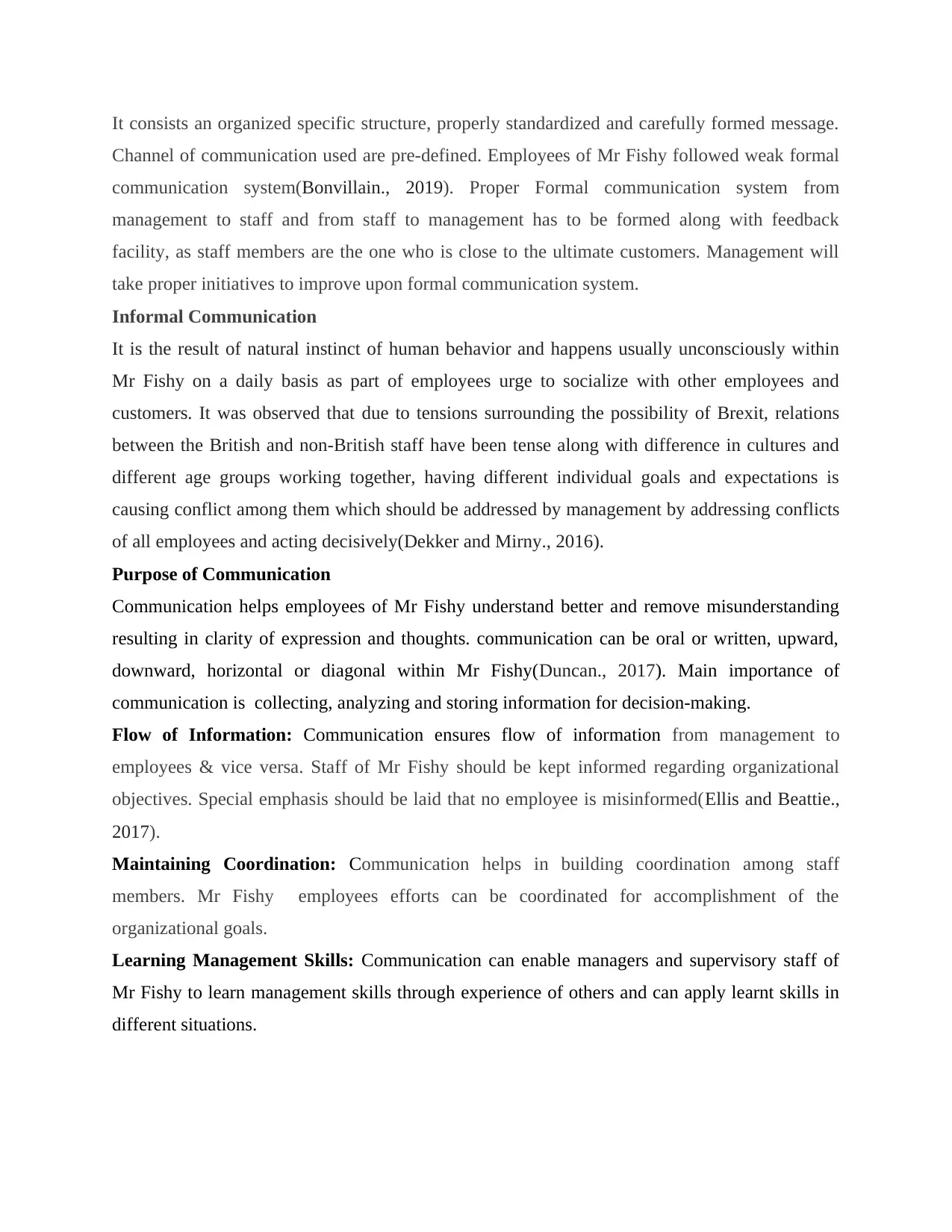
It consists an organized specific structure, properly standardized and carefully formed message.
Channel of communication used are pre-defined. Employees of Mr Fishy followed weak formal
communication system(Bonvillain., 2019). Proper Formal communication system from
management to staff and from staff to management has to be formed along with feedback
facility, as staff members are the one who is close to the ultimate customers. Management will
take proper initiatives to improve upon formal communication system.
Informal Communication
It is the result of natural instinct of human behavior and happens usually unconsciously within
Mr Fishy on a daily basis as part of employees urge to socialize with other employees and
customers. It was observed that due to tensions surrounding the possibility of Brexit, relations
between the British and non-British staff have been tense along with difference in cultures and
different age groups working together, having different individual goals and expectations is
causing conflict among them which should be addressed by management by addressing conflicts
of all employees and acting decisively(Dekker and Mirny., 2016).
Purpose of Communication
Communication helps employees of Mr Fishy understand better and remove misunderstanding
resulting in clarity of expression and thoughts. communication can be oral or written, upward,
downward, horizontal or diagonal within Mr Fishy(Duncan., 2017). Main importance of
communication is collecting, analyzing and storing information for decision-making.
Flow of Information: Communication ensures flow of information from management to
employees & vice versa. Staff of Mr Fishy should be kept informed regarding organizational
objectives. Special emphasis should be laid that no employee is misinformed(Ellis and Beattie.,
2017).
Maintaining Coordination: Communication helps in building coordination among staff
members. Mr Fishy employees efforts can be coordinated for accomplishment of the
organizational goals.
Learning Management Skills: Communication can enable managers and supervisory staff of
Mr Fishy to learn management skills through experience of others and can apply learnt skills in
different situations.
Channel of communication used are pre-defined. Employees of Mr Fishy followed weak formal
communication system(Bonvillain., 2019). Proper Formal communication system from
management to staff and from staff to management has to be formed along with feedback
facility, as staff members are the one who is close to the ultimate customers. Management will
take proper initiatives to improve upon formal communication system.
Informal Communication
It is the result of natural instinct of human behavior and happens usually unconsciously within
Mr Fishy on a daily basis as part of employees urge to socialize with other employees and
customers. It was observed that due to tensions surrounding the possibility of Brexit, relations
between the British and non-British staff have been tense along with difference in cultures and
different age groups working together, having different individual goals and expectations is
causing conflict among them which should be addressed by management by addressing conflicts
of all employees and acting decisively(Dekker and Mirny., 2016).
Purpose of Communication
Communication helps employees of Mr Fishy understand better and remove misunderstanding
resulting in clarity of expression and thoughts. communication can be oral or written, upward,
downward, horizontal or diagonal within Mr Fishy(Duncan., 2017). Main importance of
communication is collecting, analyzing and storing information for decision-making.
Flow of Information: Communication ensures flow of information from management to
employees & vice versa. Staff of Mr Fishy should be kept informed regarding organizational
objectives. Special emphasis should be laid that no employee is misinformed(Ellis and Beattie.,
2017).
Maintaining Coordination: Communication helps in building coordination among staff
members. Mr Fishy employees efforts can be coordinated for accomplishment of the
organizational goals.
Learning Management Skills: Communication can enable managers and supervisory staff of
Mr Fishy to learn management skills through experience of others and can apply learnt skills in
different situations.
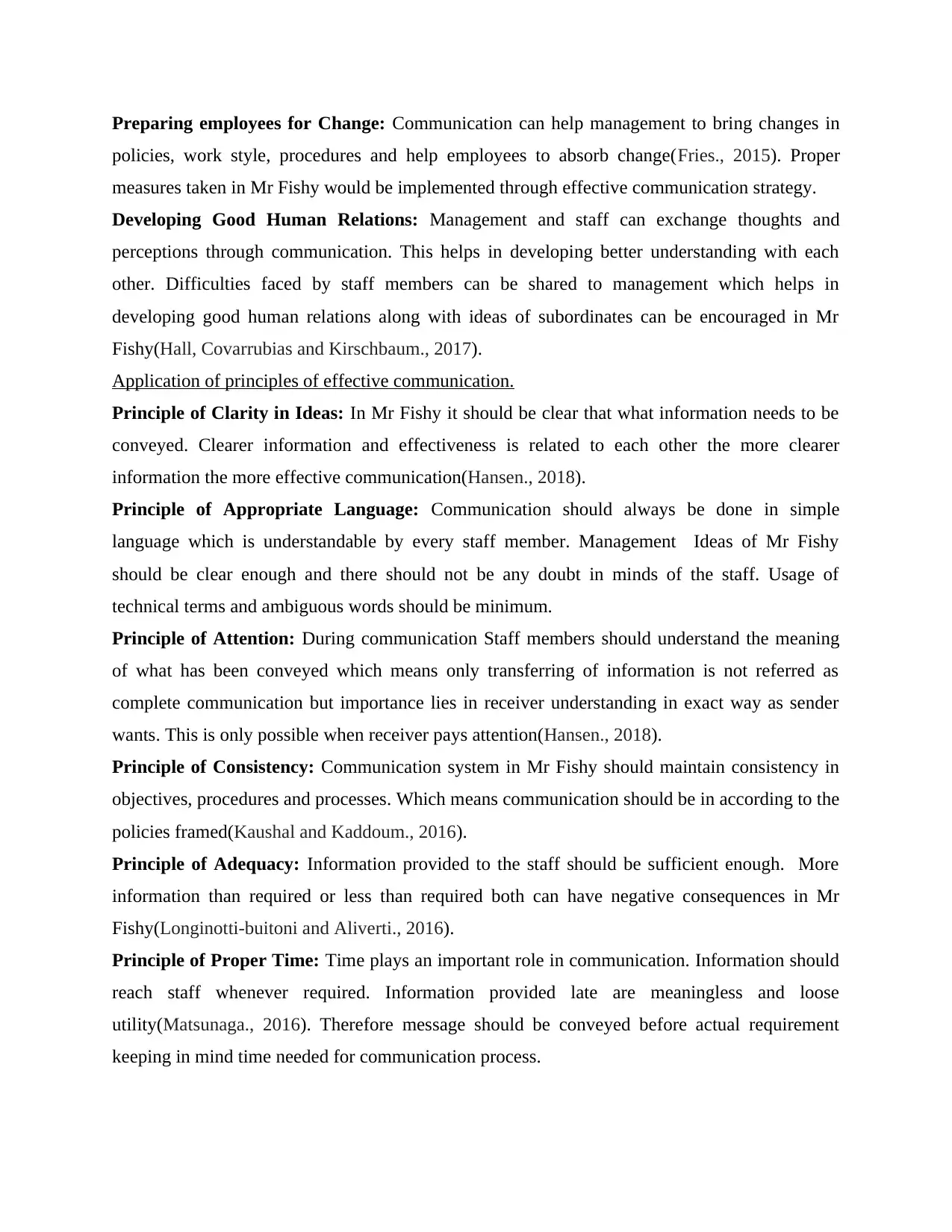
Preparing employees for Change: Communication can help management to bring changes in
policies, work style, procedures and help employees to absorb change(Fries., 2015). Proper
measures taken in Mr Fishy would be implemented through effective communication strategy.
Developing Good Human Relations: Management and staff can exchange thoughts and
perceptions through communication. This helps in developing better understanding with each
other. Difficulties faced by staff members can be shared to management which helps in
developing good human relations along with ideas of subordinates can be encouraged in Mr
Fishy(Hall, Covarrubias and Kirschbaum., 2017).
Application of principles of effective communication.
Principle of Clarity in Ideas: In Mr Fishy it should be clear that what information needs to be
conveyed. Clearer information and effectiveness is related to each other the more clearer
information the more effective communication(Hansen., 2018).
Principle of Appropriate Language: Communication should always be done in simple
language which is understandable by every staff member. Management Ideas of Mr Fishy
should be clear enough and there should not be any doubt in minds of the staff. Usage of
technical terms and ambiguous words should be minimum.
Principle of Attention: During communication Staff members should understand the meaning
of what has been conveyed which means only transferring of information is not referred as
complete communication but importance lies in receiver understanding in exact way as sender
wants. This is only possible when receiver pays attention(Hansen., 2018).
Principle of Consistency: Communication system in Mr Fishy should maintain consistency in
objectives, procedures and processes. Which means communication should be in according to the
policies framed(Kaushal and Kaddoum., 2016).
Principle of Adequacy: Information provided to the staff should be sufficient enough. More
information than required or less than required both can have negative consequences in Mr
Fishy(Longinotti-buitoni and Aliverti., 2016).
Principle of Proper Time: Time plays an important role in communication. Information should
reach staff whenever required. Information provided late are meaningless and loose
utility(Matsunaga., 2016). Therefore message should be conveyed before actual requirement
keeping in mind time needed for communication process.
policies, work style, procedures and help employees to absorb change(Fries., 2015). Proper
measures taken in Mr Fishy would be implemented through effective communication strategy.
Developing Good Human Relations: Management and staff can exchange thoughts and
perceptions through communication. This helps in developing better understanding with each
other. Difficulties faced by staff members can be shared to management which helps in
developing good human relations along with ideas of subordinates can be encouraged in Mr
Fishy(Hall, Covarrubias and Kirschbaum., 2017).
Application of principles of effective communication.
Principle of Clarity in Ideas: In Mr Fishy it should be clear that what information needs to be
conveyed. Clearer information and effectiveness is related to each other the more clearer
information the more effective communication(Hansen., 2018).
Principle of Appropriate Language: Communication should always be done in simple
language which is understandable by every staff member. Management Ideas of Mr Fishy
should be clear enough and there should not be any doubt in minds of the staff. Usage of
technical terms and ambiguous words should be minimum.
Principle of Attention: During communication Staff members should understand the meaning
of what has been conveyed which means only transferring of information is not referred as
complete communication but importance lies in receiver understanding in exact way as sender
wants. This is only possible when receiver pays attention(Hansen., 2018).
Principle of Consistency: Communication system in Mr Fishy should maintain consistency in
objectives, procedures and processes. Which means communication should be in according to the
policies framed(Kaushal and Kaddoum., 2016).
Principle of Adequacy: Information provided to the staff should be sufficient enough. More
information than required or less than required both can have negative consequences in Mr
Fishy(Longinotti-buitoni and Aliverti., 2016).
Principle of Proper Time: Time plays an important role in communication. Information should
reach staff whenever required. Information provided late are meaningless and loose
utility(Matsunaga., 2016). Therefore message should be conveyed before actual requirement
keeping in mind time needed for communication process.
⊘ This is a preview!⊘
Do you want full access?
Subscribe today to unlock all pages.

Trusted by 1+ million students worldwide
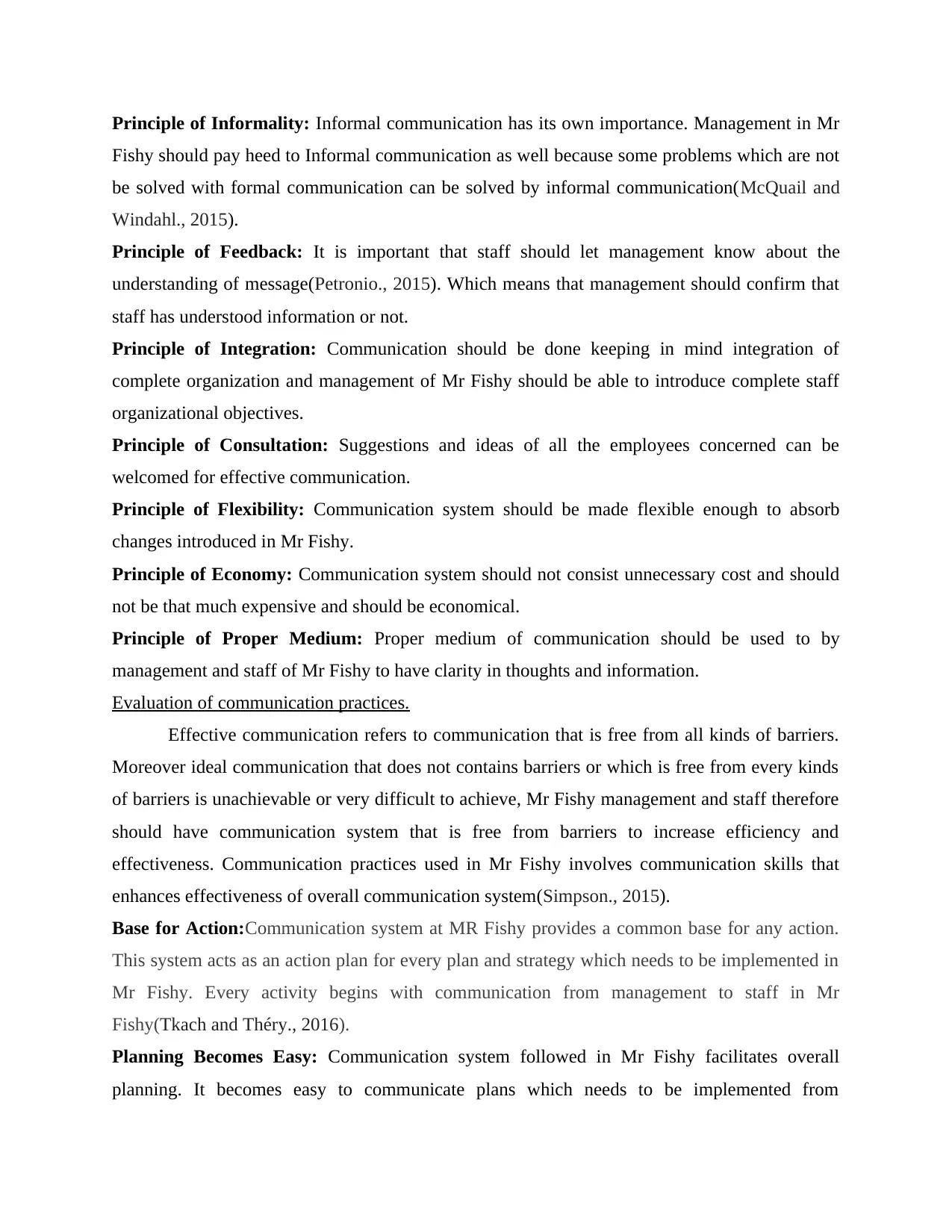
Principle of Informality: Informal communication has its own importance. Management in Mr
Fishy should pay heed to Informal communication as well because some problems which are not
be solved with formal communication can be solved by informal communication(McQuail and
Windahl., 2015).
Principle of Feedback: It is important that staff should let management know about the
understanding of message(Petronio., 2015). Which means that management should confirm that
staff has understood information or not.
Principle of Integration: Communication should be done keeping in mind integration of
complete organization and management of Mr Fishy should be able to introduce complete staff
organizational objectives.
Principle of Consultation: Suggestions and ideas of all the employees concerned can be
welcomed for effective communication.
Principle of Flexibility: Communication system should be made flexible enough to absorb
changes introduced in Mr Fishy.
Principle of Economy: Communication system should not consist unnecessary cost and should
not be that much expensive and should be economical.
Principle of Proper Medium: Proper medium of communication should be used to by
management and staff of Mr Fishy to have clarity in thoughts and information.
Evaluation of communication practices.
Effective communication refers to communication that is free from all kinds of barriers.
Moreover ideal communication that does not contains barriers or which is free from every kinds
of barriers is unachievable or very difficult to achieve, Mr Fishy management and staff therefore
should have communication system that is free from barriers to increase efficiency and
effectiveness. Communication practices used in Mr Fishy involves communication skills that
enhances effectiveness of overall communication system(Simpson., 2015).
Base for Action:Communication system at MR Fishy provides a common base for any action.
This system acts as an action plan for every plan and strategy which needs to be implemented in
Mr Fishy. Every activity begins with communication from management to staff in Mr
Fishy(Tkach and Théry., 2016).
Planning Becomes Easy: Communication system followed in Mr Fishy facilitates overall
planning. It becomes easy to communicate plans which needs to be implemented from
Fishy should pay heed to Informal communication as well because some problems which are not
be solved with formal communication can be solved by informal communication(McQuail and
Windahl., 2015).
Principle of Feedback: It is important that staff should let management know about the
understanding of message(Petronio., 2015). Which means that management should confirm that
staff has understood information or not.
Principle of Integration: Communication should be done keeping in mind integration of
complete organization and management of Mr Fishy should be able to introduce complete staff
organizational objectives.
Principle of Consultation: Suggestions and ideas of all the employees concerned can be
welcomed for effective communication.
Principle of Flexibility: Communication system should be made flexible enough to absorb
changes introduced in Mr Fishy.
Principle of Economy: Communication system should not consist unnecessary cost and should
not be that much expensive and should be economical.
Principle of Proper Medium: Proper medium of communication should be used to by
management and staff of Mr Fishy to have clarity in thoughts and information.
Evaluation of communication practices.
Effective communication refers to communication that is free from all kinds of barriers.
Moreover ideal communication that does not contains barriers or which is free from every kinds
of barriers is unachievable or very difficult to achieve, Mr Fishy management and staff therefore
should have communication system that is free from barriers to increase efficiency and
effectiveness. Communication practices used in Mr Fishy involves communication skills that
enhances effectiveness of overall communication system(Simpson., 2015).
Base for Action:Communication system at MR Fishy provides a common base for any action.
This system acts as an action plan for every plan and strategy which needs to be implemented in
Mr Fishy. Every activity begins with communication from management to staff in Mr
Fishy(Tkach and Théry., 2016).
Planning Becomes Easy: Communication system followed in Mr Fishy facilitates overall
planning. It becomes easy to communicate plans which needs to be implemented from
Paraphrase This Document
Need a fresh take? Get an instant paraphrase of this document with our AI Paraphraser
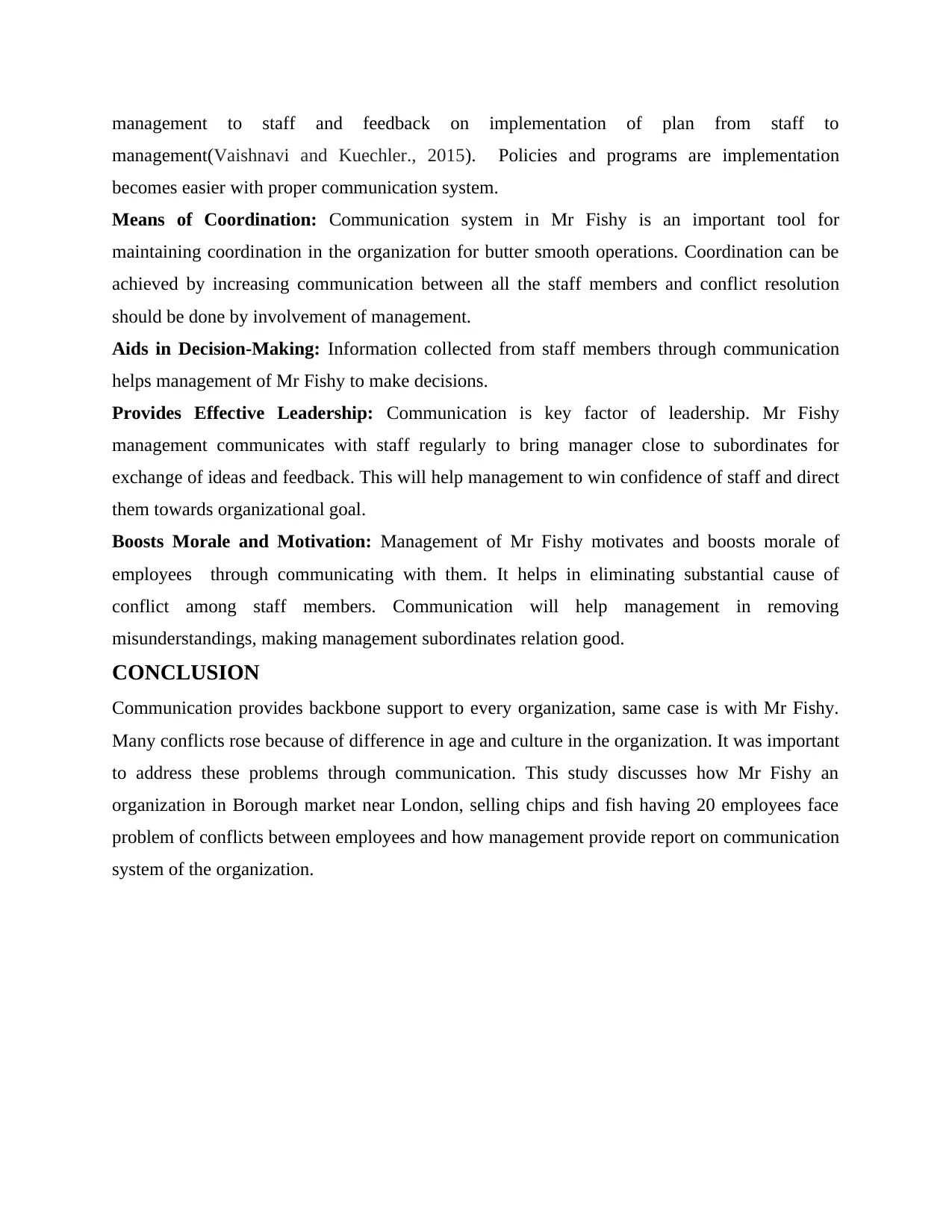
management to staff and feedback on implementation of plan from staff to
management(Vaishnavi and Kuechler., 2015). Policies and programs are implementation
becomes easier with proper communication system.
Means of Coordination: Communication system in Mr Fishy is an important tool for
maintaining coordination in the organization for butter smooth operations. Coordination can be
achieved by increasing communication between all the staff members and conflict resolution
should be done by involvement of management.
Aids in Decision-Making: Information collected from staff members through communication
helps management of Mr Fishy to make decisions.
Provides Effective Leadership: Communication is key factor of leadership. Mr Fishy
management communicates with staff regularly to bring manager close to subordinates for
exchange of ideas and feedback. This will help management to win confidence of staff and direct
them towards organizational goal.
Boosts Morale and Motivation: Management of Mr Fishy motivates and boosts morale of
employees through communicating with them. It helps in eliminating substantial cause of
conflict among staff members. Communication will help management in removing
misunderstandings, making management subordinates relation good.
CONCLUSION
Communication provides backbone support to every organization, same case is with Mr Fishy.
Many conflicts rose because of difference in age and culture in the organization. It was important
to address these problems through communication. This study discusses how Mr Fishy an
organization in Borough market near London, selling chips and fish having 20 employees face
problem of conflicts between employees and how management provide report on communication
system of the organization.
management(Vaishnavi and Kuechler., 2015). Policies and programs are implementation
becomes easier with proper communication system.
Means of Coordination: Communication system in Mr Fishy is an important tool for
maintaining coordination in the organization for butter smooth operations. Coordination can be
achieved by increasing communication between all the staff members and conflict resolution
should be done by involvement of management.
Aids in Decision-Making: Information collected from staff members through communication
helps management of Mr Fishy to make decisions.
Provides Effective Leadership: Communication is key factor of leadership. Mr Fishy
management communicates with staff regularly to bring manager close to subordinates for
exchange of ideas and feedback. This will help management to win confidence of staff and direct
them towards organizational goal.
Boosts Morale and Motivation: Management of Mr Fishy motivates and boosts morale of
employees through communicating with them. It helps in eliminating substantial cause of
conflict among staff members. Communication will help management in removing
misunderstandings, making management subordinates relation good.
CONCLUSION
Communication provides backbone support to every organization, same case is with Mr Fishy.
Many conflicts rose because of difference in age and culture in the organization. It was important
to address these problems through communication. This study discusses how Mr Fishy an
organization in Borough market near London, selling chips and fish having 20 employees face
problem of conflicts between employees and how management provide report on communication
system of the organization.
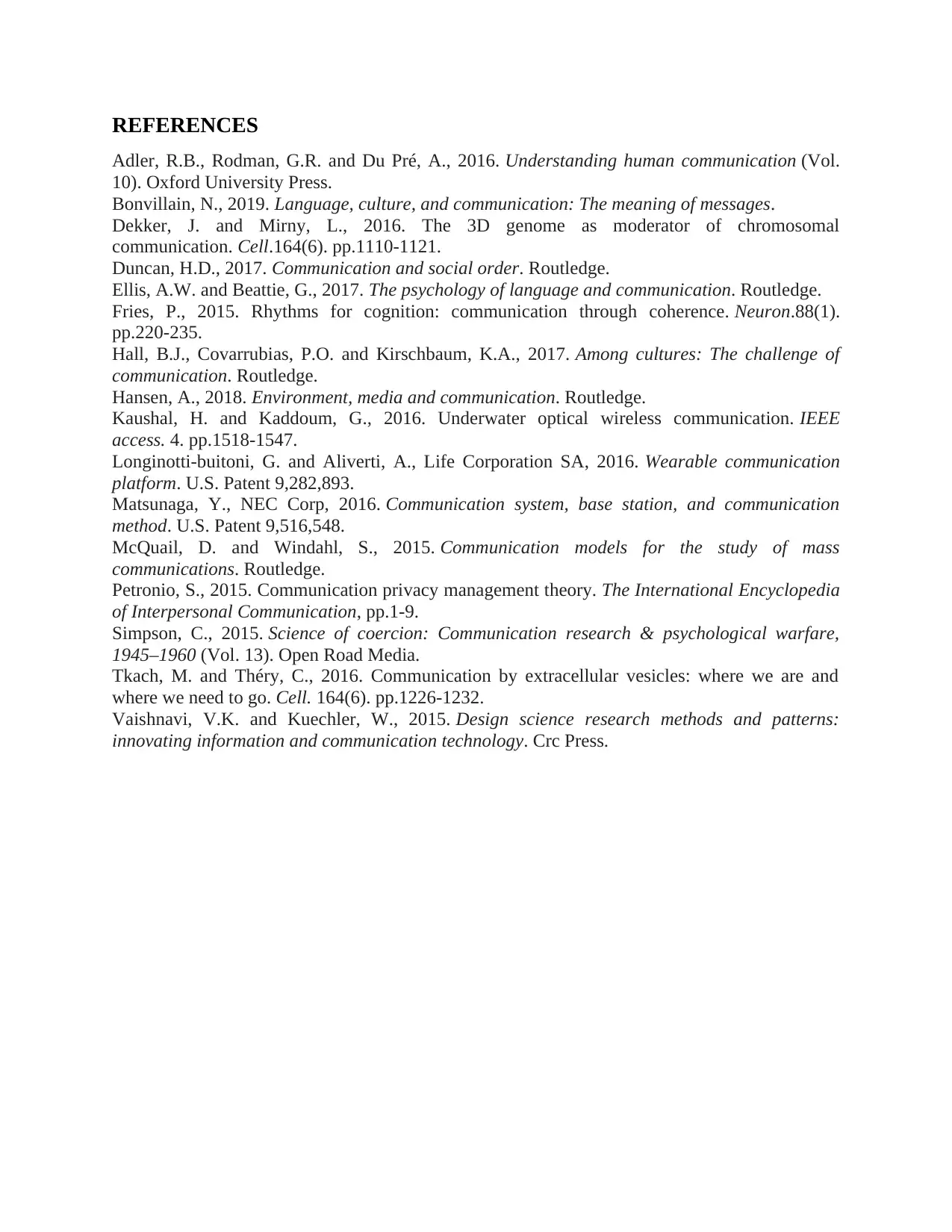
REFERENCES
Adler, R.B., Rodman, G.R. and Du Pré, A., 2016. Understanding human communication (Vol.
10). Oxford University Press.
Bonvillain, N., 2019. Language, culture, and communication: The meaning of messages.
Dekker, J. and Mirny, L., 2016. The 3D genome as moderator of chromosomal
communication. Cell.164(6). pp.1110-1121.
Duncan, H.D., 2017. Communication and social order. Routledge.
Ellis, A.W. and Beattie, G., 2017. The psychology of language and communication. Routledge.
Fries, P., 2015. Rhythms for cognition: communication through coherence. Neuron.88(1).
pp.220-235.
Hall, B.J., Covarrubias, P.O. and Kirschbaum, K.A., 2017. Among cultures: The challenge of
communication. Routledge.
Hansen, A., 2018. Environment, media and communication. Routledge.
Kaushal, H. and Kaddoum, G., 2016. Underwater optical wireless communication. IEEE
access. 4. pp.1518-1547.
Longinotti-buitoni, G. and Aliverti, A., Life Corporation SA, 2016. Wearable communication
platform. U.S. Patent 9,282,893.
Matsunaga, Y., NEC Corp, 2016. Communication system, base station, and communication
method. U.S. Patent 9,516,548.
McQuail, D. and Windahl, S., 2015. Communication models for the study of mass
communications. Routledge.
Petronio, S., 2015. Communication privacy management theory. The International Encyclopedia
of Interpersonal Communication, pp.1-9.
Simpson, C., 2015. Science of coercion: Communication research & psychological warfare,
1945–1960 (Vol. 13). Open Road Media.
Tkach, M. and Théry, C., 2016. Communication by extracellular vesicles: where we are and
where we need to go. Cell. 164(6). pp.1226-1232.
Vaishnavi, V.K. and Kuechler, W., 2015. Design science research methods and patterns:
innovating information and communication technology. Crc Press.
Adler, R.B., Rodman, G.R. and Du Pré, A., 2016. Understanding human communication (Vol.
10). Oxford University Press.
Bonvillain, N., 2019. Language, culture, and communication: The meaning of messages.
Dekker, J. and Mirny, L., 2016. The 3D genome as moderator of chromosomal
communication. Cell.164(6). pp.1110-1121.
Duncan, H.D., 2017. Communication and social order. Routledge.
Ellis, A.W. and Beattie, G., 2017. The psychology of language and communication. Routledge.
Fries, P., 2015. Rhythms for cognition: communication through coherence. Neuron.88(1).
pp.220-235.
Hall, B.J., Covarrubias, P.O. and Kirschbaum, K.A., 2017. Among cultures: The challenge of
communication. Routledge.
Hansen, A., 2018. Environment, media and communication. Routledge.
Kaushal, H. and Kaddoum, G., 2016. Underwater optical wireless communication. IEEE
access. 4. pp.1518-1547.
Longinotti-buitoni, G. and Aliverti, A., Life Corporation SA, 2016. Wearable communication
platform. U.S. Patent 9,282,893.
Matsunaga, Y., NEC Corp, 2016. Communication system, base station, and communication
method. U.S. Patent 9,516,548.
McQuail, D. and Windahl, S., 2015. Communication models for the study of mass
communications. Routledge.
Petronio, S., 2015. Communication privacy management theory. The International Encyclopedia
of Interpersonal Communication, pp.1-9.
Simpson, C., 2015. Science of coercion: Communication research & psychological warfare,
1945–1960 (Vol. 13). Open Road Media.
Tkach, M. and Théry, C., 2016. Communication by extracellular vesicles: where we are and
where we need to go. Cell. 164(6). pp.1226-1232.
Vaishnavi, V.K. and Kuechler, W., 2015. Design science research methods and patterns:
innovating information and communication technology. Crc Press.
⊘ This is a preview!⊘
Do you want full access?
Subscribe today to unlock all pages.

Trusted by 1+ million students worldwide

1
1 out of 10
Related Documents
Your All-in-One AI-Powered Toolkit for Academic Success.
+13062052269
info@desklib.com
Available 24*7 on WhatsApp / Email
![[object Object]](/_next/static/media/star-bottom.7253800d.svg)
Unlock your academic potential
Copyright © 2020–2025 A2Z Services. All Rights Reserved. Developed and managed by ZUCOL.





